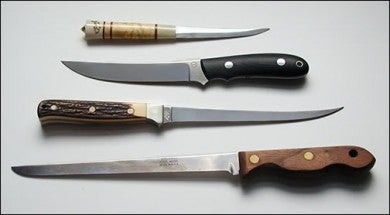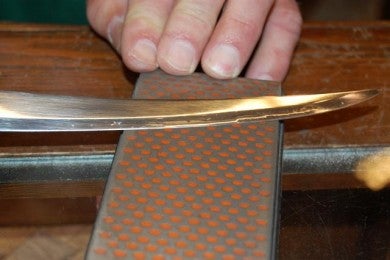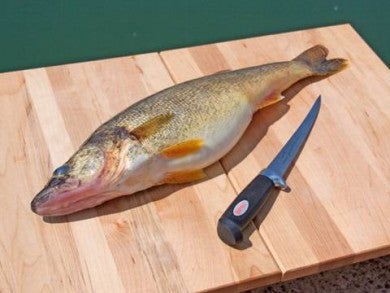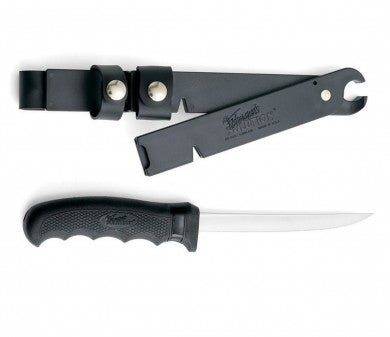Choosing a Good Filet Knife
Bob McNally 08.02.15
)
Debates on what constitutes a good knife, what’s the best knife steel, and how to best sharpen a knife can go on forever. I can’t give much insight into Rockwell hardness or knife design histories, but I do know what I like in filleting blades. What I prefer may not be what other anglers desire, but here are my thoughts anyway.
I believe there are basically two schools of thought about knives, especially fillet knives used around the water. One is that since the knife will be abused, subject to rusting, and probably will be dropped overboard anyway, it’s smart to buy an inexpensive, soft-steel knife that’s easy to sharpen and a snap to replace. The other school of thought regarding a fillet knife is to buy a top-quality, expensive one with hard steel that will hold a non-corrosive edge a long time–then take care of it forever.
Both schools of thought have merit, depending on how the angler intends to use the knife and how well he believes he can care for it. Personally, I want a soft-steel knife that I easily can put an edge on with a convenient, hand-held sharpening tool while rocking in my boat in bumpy water. I just never seem to have the time to sit at home (on the hearth, in front of the fire, no doubt) and strap the knife edge sharper than a snook’s gill cover.
Further, I want a knife that’s impervious to corrosion, so high-grade stainless steel is a must. This brings up the point of knife sheaths, because cloth or leather ones absorb moisture and salt, and a knife stored for long periods in even a dry sheath impregnated with salt can lead to a rusted blade. Thus, hard-plastic sheaths are most desirable for knives used in a marine environment.
Some anglers spray their knife blades with a bit of oil after using them and before storing them in sheaths. It’s a good idea, but a better way is to use cooking oil or even Crisco, as it’s considerably more palatable than WD-40 next time the blade is stroking fish flesh.
I like a thin, soft-blade fillet knife that is easy to use when skinning even thin-skin species such as catfish, bluefish, or mackerel. For skinning, it’s important the blade bend a bit to provide the right angle to zip flesh from hide, but the blade must have just the right about of “bend.” The blade shouldn’t be as soft as a coat hanger, but the stiffness of a deer skinning knife is no good either.
What constitutes a good degree of “blade bend” is purely subjective for a fisherman, and it’s something that only can be learned through experience.
Long, soft knife blades are difficult to use in close-quarters cutting work, such as boning, making special fillet cuts along “Y-bones,” and removing fish cheeks. For this reason, I usually have two fillet knives along on most trips. One blade is 6-inches, very thin, and not very soft. This knife is used for tight-quarters boning and for smaller fish such as bluegills, mangrove snapper, and trout. The second knife has a 9-inch, soft blade. The long blade makes it easy to remove deep-body fish fillets, such as hefty salmon, striped bass, oversize redfish, wahoo, and dolphin. Skinning deep fillets is easy with the long-blade knife, too.
One interesting innovation in fillet knife design that addresses my two-knife system are the “Adjustable” fillet knives by companies such as Kershaw and Cutco. A special lock mechanism allows the user to adjust the knife blade from 5-to-9 inches, thus the knife serves both large and small fish boning and skinning functions, and the shorter blade is stiffer than when the blade is fully extended. Also, the knife is easy to store in a tackle box or bag in its shorter length.
There are a number of excellent folding fillet knives on the market today, which allow for easy storage and no need for sheaths. The Schrade “Mighty Angler” is one of the best I’ve seen, as its blade is soft, easy-to-sharpen, and the folded knife stores conveniently in a durable sheath that stows in a tackle box or on an angler’s waist belt.
One important aspect to consider with folding filet knives is ease of cleaning. Gaps, holes, and hinges all collect blood and flesh, so it’s imperative the knife can be worked in such ways as to allow easy cleaning. Some folding and fixed-blade fillets knives allow blade removal so they can be thoroughly cleaned and dried following use, which also helps prevent tarnishing of parts.
A very pointed, sharp tip is another important part of a good fillet knife since it allows for quick, safe penetration of the blade into a fish for dressing. Also, a well-designed, easy-to-grasp, non-slip handle is very important because a slimy hand slipping at the wrong instant can result in injury.



